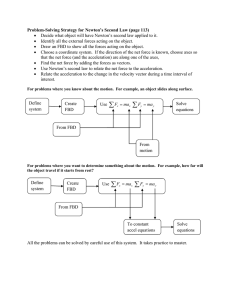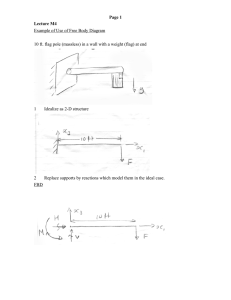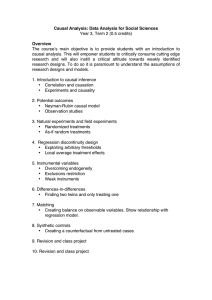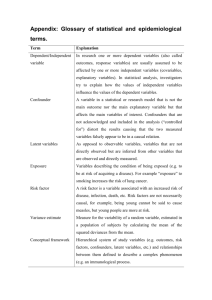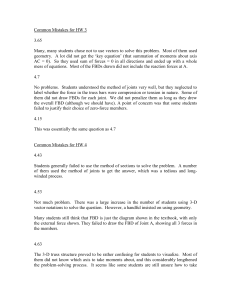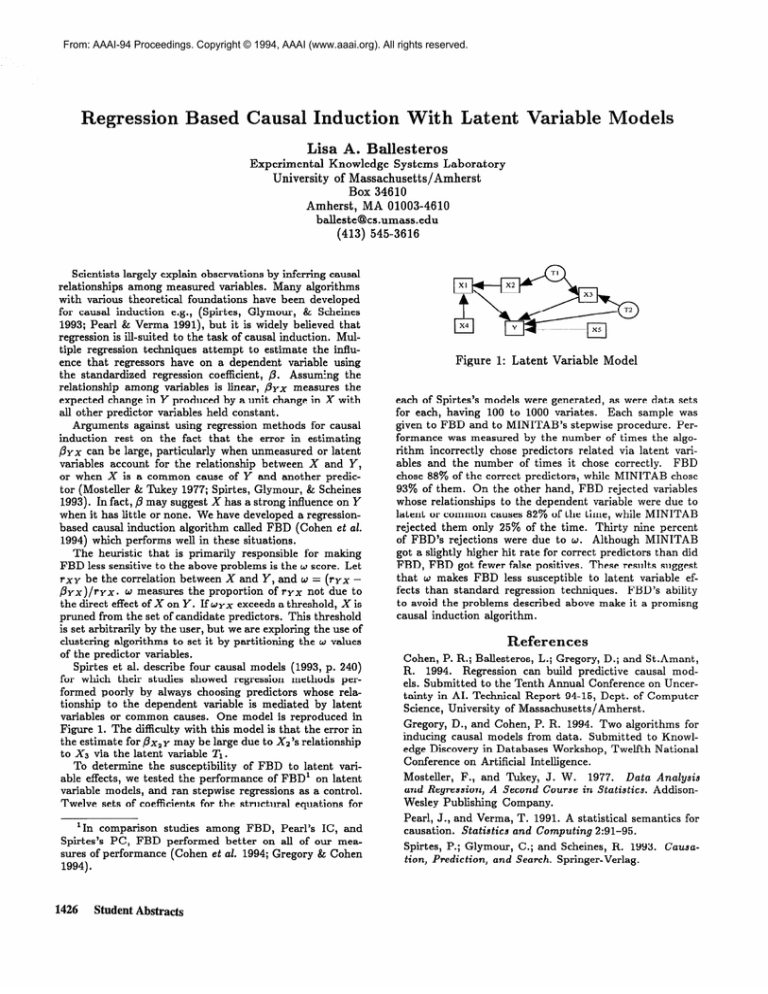
From: AAAI-94 Proceedings. Copyright © 1994, AAAI (www.aaai.org). All rights reserved.
Regression Based Causal Induction With Latent Variable Models
Lisa A. Ballesteros
Experimental
Knowledge Systems Laboratory
University of Massachusetts/Amherst
Box 34610
Amherst, MA 01003-4610
ballesteQcs.umass.edu
(413) 545-3616
Scientists largely explain observations by inferring causal
relationships among measured variables. Many algorithms
with various theoretical foundations have been developed
for causal induction e.g., (Spirtes, Glymour,
& Scheines
1993; Pearl & Verma 1991), but it is widely believed that
regression is ill-suited to the task of causal induction. Multiple regression techniques attempt to estimate the influence that regressors have on a dependent variable using
the standardized
regression coefficient,
p. Assuming the
measures the
relationship among variables is linear, pyx
expected change in Y produced by a unit change in X with
all other predictor variables held constant.
Arguments
against using regression methods for causal
induction
rest on the fact that the error in estimating
pyx
can be large, particularly when unmeasured or latent
variables account for the relationship between X and Y,
or when X is a common cause of Y and another predictor (Mosteller & Tukey 1977; Spirtes, Glymour, & Scheines
1993). In fact, p may suggest X has a strong influence on Y
when it has little or none. We have developed a regressionbased causal induction algorithm called FBD (Cohen et ol.
1994) which performs well in these situations.
The heuristic that is primarily responsible for making
FBD less sensitive to the above problems is the w score. Let
rx y be the correlation between X and Y, and w = (ryx @yx)/ryx.
w measures the proportion
of ryx not due to
the direct effect of X on Y. If wyx exceeds a threshold, X is
pruned from the set of candidate predictors. This threshold
is set arbitrarily by the user, but we are exploring the use of
clustering algorithms to set it by partitioning
the w values
of the predictor variables.
Spirtes et al. describe four causal models (1993, p. 240)
for which their studies showed regression methods performed poorly by always choosing predictors whose relationship to the dependent variable is mediated by latent
variables or common causes. One model is reproduced in
Figure 1. The difficulty with this model is that the error in
the estimate for px, y may be large due to X2’s relationship
to X3 via the latent variable 2’1.
To determine the susceptibility
of FBD to latent variable effects, we tested the performance
of FBD’ on latent
variable models, and ran stepwise regressions as a control.
Twelve sets of coefficients for the structural equations for
‘In comparison
studies among FBD, Pearl’s IC, and
Spirtes’s PC, FBD performed
better on all of our measures of performance
(Cohen et osl. 1994; Gregory & Cohen
1994).
1426
Student Abstracts
Figure
1: Latent
Variable
Model
each of Spirtes’s models were generated, as were data sets
for each, having 100 to 1000 variates.
Each sample was
given to FBD and to MINITAB’s
stepwise procedure. Performance was measured by the number of times the algorithm incorrectly
chose predictors related via latent variables and the number of times it chose correctly.
FBD
chose 88% of the correct predictors, while MINITAB
chose
93% of them. On the other hand, FBD rejected variables
whose relationships to the dependent variable were due to
latent or common causes 82% of the time, while MINITAB
rejected them only 25% of the time. Thirty nine percent
of FBD’s rejections were due to w. Although MINITAB
got a slightly higher hit rate for correct predictors than did
FBD, FBD got fewer false positives. These results suggest
that w makes FBD less susceptible to latent variable effects than standard regression techniques.
FBD’s ability
to avoid the problems described above make it a promisng
causal induction algorithm.
eferences
Cohen, P. R.; Ballesteros, L.; Gregory, D.; and St.Amant,
R. 1994. Regression can build predictive
causal models. Submitted to the Tenth Annual Conference on Uncertainty in AI. Technical Report 94-15, Dept. of Computer
Science, University of Massachusetts/Amherst.
Gregory, D., and Cohen, P. R. 1994. Two algorithms for
inducing causal models from data. Submitted to Knowledge Discovery in Dat.abases Workshop, Twelfth National
Conference on Artificial Intelligence.
Mosteller,
F., and Tukey, J. W.
and Regression, A Second
Course
Wesley Publishing Company.
1977. Dota Analysis
in Statistics.
Addison-
Pearl, J., and Verma, T. 1991. A statistical semantics
causation. Statistics
and Computing
2:91-95.
Spirtes, P.; Glymour, C.; and Scheines, R. 1993.
tion, Prediction,
arnd Search. Springer-Verlag.
for
Causca-

